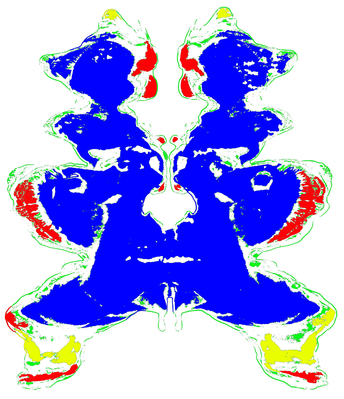Hermann Rorschach1884–1922
Rorschach used ink blots to gain indirect access to the subconscious. Rather than associating freely as in psychoanalysis, the associations were focused by non-specific or accidental forms: “The production of such accidental forms is very simple: a few large ink blots are thrown on a piece of paper, the paper folded, and the ink spread between the two halves of the sheet”. The Rorschach test, published in 1921 as Psychodiagnostics, consists of ten ink blots, half of which are coloured. The use of ink blots was by no means new. They were used by the physician Justinus Kerner (1786-1862) to provide inspiration for his poetry; he appreciated the difficulty of avoiding projecting meaning into the ink blots, but he did not pursue the individual differences of such projections. Binet did suggest that ink blots could be used to assess personality, but it was left to Rorschach to develop an ink blot test for psychodiagnostic purposes. The stimuli are presented to patients in a set order and their descriptions are noted. Scoring is in terms of how the various parts of the patterns are described rather than imaginative projections - to the form of the responses rather than their content. Particular emphasis is placed on responses to colour and to movement, to the number of associations, and to descriptions relating to the whole ink blot and parts of it. The vagaries of scoring the tests exercised those who used it considerably, and complicated schemes were devised that required extensive training by those who administered the test. The Rorschach test was but one of a variety of projective tests that were phenomenally popular in the middle decades of the century. The Thematic Apperception Test (TAT), introduced in 1935, utilized twenty drawings concerning which subjects told a story. Such tests were a reaction to the self-report inventories and led to the Minnesota Multiphasic Personality Inventory (MMPI). The inventories might not have disclosed regions of the unconscious, but they were more amenable to scoring and analysis. The popularity of projective tests waned from the 1960s, in part because of the difficulties of validating them, and in part because they did not place sufficient emphasis on the social dimension. Rorschach was born in Zurich and was nicknamed ‘Kleck’ by his schoolfriends; this turned out to be a prescient appellation as ‘Klecks’ are ink blots! He studied medicine at the Universities of Berlin and Bonn, and graduated from the University of Zurich. He worked with Bleuler, and was influenced by Freud’s psychoanalytic theory and by Jung’s typology: personality was described in terms of introversive and extratensive types, and the aim of development was to reach some state of “ambiequality”. Rorschach commenced his investigations of ink blots in 1911; initially he compared word associations in children to responses to ink blots. His psychodiagnostic stimuli reflect the symmetry of the human face, hence this specially constructed coloured ink blot reflects the symmetry of Rorschach’s portrait, although it will require a degree of projection on behalf of the observer to see him.
